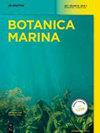台湾沙滩的海生真菌
IF 1.4
4区 生物学
Q2 MARINE & FRESHWATER BIOLOGY
引用次数: 2
摘要
摘要本研究调查了台湾11个沙滩上的砂质海洋真菌(仅在沙粒上形成子实体的真菌)的形态多样性。通过子囊孢子形态鉴定了科罗菌属的物种,并通过28S rDNA与其他已发表序列的系统发育分析进行了确认。系统发育分析揭示了四个以前未知的Corolospora分支。与C.portsaidica有关,同时观察到这四个分支中分离株的子囊孢子形态存在差异。从11个沙滩上共鉴定出13种芳烃海洋真菌,包括2种阿伦纳氏菌属、9种科罗菌属(包括4个未知的科罗菌分支)、粗糙科勒美菌属和碳球藻属。塔安海滩的物种丰富度最高(8种),其次是永镇海洋公园和皮西里安(各5种)。香农多样性指数显示,大安海滩的多样性最高(1.51),皮西里安(1.44),但与前者(0.73)相比,后者的多样性更为均匀(Pielou均匀度指数=0.9)。非计量多维尺度表明,台湾东西海岸的真菌群落组成普遍存在差异。本文章由计算机程序翻译,如有差异,请以英文原文为准。
Arenicolous marine fungi of sandy beaches of Taiwan
Abstract This study investigated the morphological diversity of arenicolous marine fungi (only those forming fruiting bodies on sand grains) at 11 sandy beaches in Taiwan. The species of Corollospora were identified by ascospore morphology and confirmed through a phylogenetic analysis of the 28S rDNA with other published sequences. The phylogenetic analysis revealed four previously unknown clades of Corollospora spp. related to C. portsaidica, while differences in ascospore morphology of the isolates in these four clades were observed. A total of 13 species of arenicolous marine fungi was identified from the 11 sandy beaches, including two Arenariomyces spp., nine Corollospora spp. (including four unknown Corollospora clades), Kohlmeyeriella crassa and Carbosphaerella cf sp. Taan Beach had the highest species richness (eight species), followed by Yongzhen Sea Park and Pisirian (five species each). The Shannon’s diversity index revealed the highest diversity at Taan Beach (1.51) over Pisirian (1.44), but the diversity was more even at the latter site (Pielou’s evenness index = 0.9) compared with the former (0.73). Non-metric multidimensional scaling suggests that there was generally a divide in the fungal community composition between the east and the west coasts of Taiwan.
求助全文
通过发布文献求助,成功后即可免费获取论文全文。
去求助
来源期刊

Botanica Marina
生物-海洋与淡水生物学
CiteScore
4.10
自引率
4.50%
发文量
43
期刊介绍:
Botanica Marina publishes high-quality contributions from all of the disciplines of marine botany at all levels of biological organisation from subcellular to ecosystem: chemistry and applications, genomics, physiology and ecology, phylogeny and biogeography. Research involving global or interdisciplinary interest is especially welcome. Applied science papers are appreciated, particularly when they illustrate the application of emerging conceptual issues or promote developing technologies. The journal invites state-of-the art reviews dealing with recent developments in marine botany.
 求助内容:
求助内容: 应助结果提醒方式:
应助结果提醒方式:


